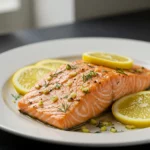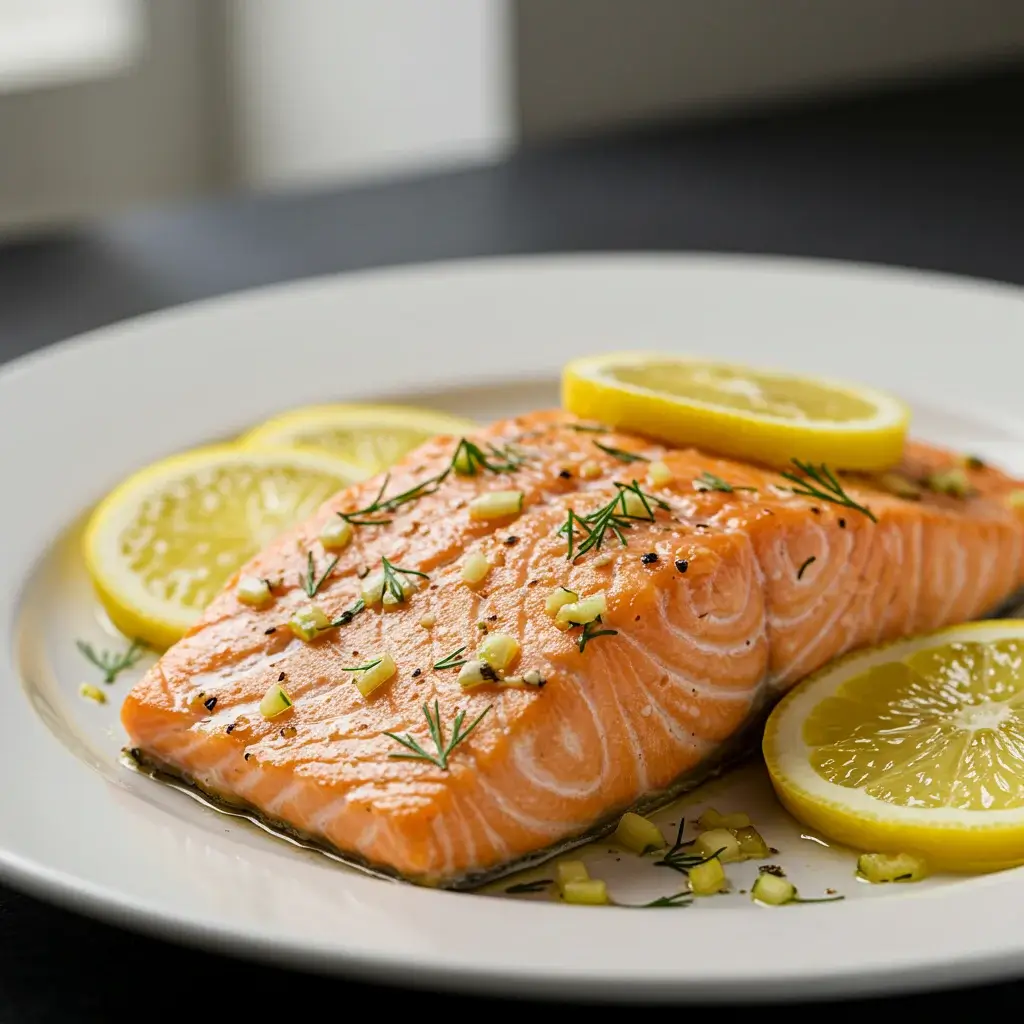Salmon fillets are a culinary delight cherished by many for their rich flavor and nutritional benefits. The Upper East Side Salmon Fillet recipe combines simplicity and elegance, making it a perfect dish for both casual dinners and special occasions. In this comprehensive guide, we’ll take you through the ingredients, instructions, nutritional benefits, serving suggestions, and additional tips to perfect this dish. Let’s dive into the world of delicious salmon!
Ingredients
To create the perfect Upper East Side Salmon Fillet, you’ll need the following ingredients:
- 2 salmon fillets
- 2 tablespoons olive oil
- 2 cloves garlic, minced
- 1 tablespoon fresh dill or 1 teaspoon dried
- Juice of 1 lemon
- Salt and pepper to taste
- Lemon slices for garnish
Each ingredient plays a vital role in enhancing the taste and aroma of the dish. The freshness of the salmon, the zest of lemon, and the aromatic dill come together to create a harmonious flavor profile.
Instructions
Creating the Upper East Side Salmon Fillet is straightforward and requires minimal preparation time. Follow these steps to achieve a perfectly cooked salmon dish:
- Preheat the oven to 400°F (200°C).
- In a small bowl, mix olive oil, garlic, dill, lemon juice, salt, and pepper. This mixture serves as a flavorful marinade that will infuse the salmon with aromatic goodness.
- Place salmon fillets on a baking sheet lined with parchment paper. The parchment paper prevents sticking and ensures even cooking.
- Brush the oil mixture over the fillets, making sure to coat them evenly. This step is crucial for achieving a well-seasoned and moist salmon.
- Bake for 12-15 minutes or until the salmon flakes easily with a fork. The cooking time may vary slightly depending on the thickness of the fillets.
- Garnish with lemon slices before serving. The lemon slices add a fresh citrusy aroma and elevate the dish’s presentation.
Nutrition Facts
Understanding the nutritional value of your meals is important for maintaining a balanced diet. Here is the nutritional breakdown for each serving of the Upper East Side Salmon Fillet:
- Calories: 350
- Protein: 34g
- Fat: 22g
- Carbohydrates: 0g
- Fiber: 0g
- Sugar: 0g
Salmon is an excellent source of high-quality protein and healthy fats, particularly omega-3 fatty acids, which are known for their numerous health benefits, including supporting heart health and reducing inflammation.
How to Serve
The Upper East Side Salmon Fillet can be served in various ways to suit different occasions and preferences, enhancing both its flavor and presentation. Here are some detailed suggestions to elevate your dining experience:
As a Main Course
When serving the salmon fillet as a main course, consider creating a balanced plate with complementary side dishes. A fresh green salad can be a delightful accompaniment, featuring a mix of leafy greens such as romaine, spinach, or mixed baby greens. Add a medley of vegetables, such as cherry tomatoes, cucumbers, and radishes, tossed in a light vinaigrette to enhance the freshness of the dish. Alternatively, roasted vegetables like asparagus, Brussels sprouts, or bell peppers can add depth and a smoky flavor profile, making for a nutritious and visually appealing meal.
With Grains
Incorporating grains into your meal not only adds texture but also provides essential nutrients. Pair the salmon with quinoa, which is rich in protein and has a slightly nutty flavor that complements the fish perfectly. For a heartier option, brown rice or couscous can be used, both of which absorb flavors well and can be seasoned with herbs or spices to enhance the overall dish. For instance, try mixing in some chopped parsley or dill, along with a squeeze of lemon, to brighten the flavors and tie the dish together.
On a Bed of Greens
For a more elegant presentation, serve the salmon on a bed of greens. Spinach or arugula works wonderfully, as their peppery notes add a layer of complexity to the dish. Drizzle the plate with a bit of balsamic glaze or a homemade vinaigrette made from olive oil, lemon juice, and a touch of honey. This not only adds a touch of sophistication but also creates a delightful contrast with the richness of the salmon. Garnishing with toasted nuts, such as slivered almonds or walnuts, can provide an additional crunch and elevate the dish’s overall texture.
With a Side of Potatoes
Potatoes are a classic pairing with salmon, offering versatility in preparation methods. Whether you choose mashed potatoes, roasted potatoes, or boiled potatoes, each option brings a unique flavor and texture to the plate. For mashed potatoes, consider adding garlic or cream for richness, and for roasted potatoes, toss them with rosemary or thyme for an aromatic touch. A dollop of sour cream or a sprinkle of chives can also enhance the dish. Boiled potatoes can be enjoyed with a simple herb butter or a light sprinkling of sea salt and fresh herbs, allowing the natural flavors to shine.
Accompaniments and Sauces
To further elevate your salmon dish, consider adding complementary sauces or sides. A lemon-dill sauce or a honey mustard glaze can enhance the flavor profile and add moisture to the dish. Additionally, a side of sautéed greens—such as kale, Swiss chard, or collard greens—can provide a nutritious and flavorful contrast. A small serving of pickled vegetables or a tangy salsa verde can also add a refreshing element that brightens the overall meal.
Wine Pairing
The right beverage can enhance the dining experience. For a sophisticated touch, consider pairing the Upper East Side Salmon Fillet with a glass of Sauvignon Blanc or a light Pinot Noir. The crisp acidity of Sauvignon Blanc complements the richness of the salmon, while a soft Pinot Noir can enhance the flavors without overwhelming them. For non-alcoholic options, a sparkling water infused with lemon or a light herbal tea can be refreshing choices.
By thoughtfully selecting accompaniments and presentation styles, the Upper East Side Salmon Fillet can be transformed into an exquisite dining experience suitable for any occasion, whether it be a casual family dinner or an elegant gathering with friends.
Additional Tips
Enhancing your cooking experience and achieving the best results with salmon requires attention to detail and a bit of creativity. Here are some comprehensive tips to elevate your salmon dish:
Choose Fresh Salmon
When selecting salmon, prioritize freshness to guarantee the best flavor and texture. Look for fillets that have the following characteristics:
- Color: Fresh salmon should have a vibrant color, which can range from deep pink to reddish-orange, depending on the species. Avoid any fillets that appear dull or discolored.
- Texture: The flesh should be firm to the touch and bounce back when pressed. If the flesh feels mushy, it’s a sign that the fish may not be fresh.
- Smell: Fresh salmon should have a clean, ocean-like smell. A strong, fishy odor is a warning sign of spoilage.
- Source: Whenever possible, buy salmon from reputable sources, such as local fish markets or trusted grocery stores that prioritize sustainability. Wild-caught salmon often has a richer flavor compared to farmed varieties.
Adjust the Seasoning
Seasoning is crucial to enhancing the natural flavor of salmon. Here are some guidelines for tailoring your seasoning to your taste:
- Garlic: If you love garlic, consider using roasted garlic for a sweeter, more mellow flavor or adding garlic powder for a more intense taste.
- Dill: While dill is a classic pairing with salmon, don’t hesitate to modify the quantity based on your preference. If you find dill overpowering, reduce the amount or substitute it with other herbs.
- Citrus: Lemon juice is a wonderful addition, but you can also experiment with other citruses like lime or orange for a unique twist. Zesting the fruit before juicing can add an extra layer of flavor.
- Spices: Consider incorporating spices like smoked paprika, cumin, or black pepper to add depth and warmth to your seasoning mix. A pinch of cayenne or red pepper flakes can introduce a subtle heat that pairs beautifully with the richness of salmon.
Monitor Cooking Time
Salmon is best when it’s cooked just right, so keeping a close eye on the cooking time is essential:
- Cooking Method: Whether you’re baking, grilling, or pan-searing, the cooking method can affect timing. For instance, baking at a moderate temperature (around 375°F or 190°C) usually takes about 12-15 minutes for a 1-inch thick fillet.
- Visual Cues: Look for visual cues like the salmon turning opaque and the edges beginning to flake. You can gently press the top of the fillet with a fork; if it flakes easily, it’s time to remove it from the heat.
- Resting Time: After cooking, let the salmon rest for a few minutes to allow the juices to redistribute, ensuring a moist and flavorful piece.
Experiment with Herbs
While dill is often the herb of choice for salmon, diversifying your herb selection can lead to exciting new flavor combinations:
- Thyme: Fresh thyme adds a subtle earthiness that pairs well with the richness of salmon. Use it fresh or dried, and consider combining it with garlic for a savory blend.
- Parsley: Fresh parsley can brighten the dish and add a touch of color. Its mild flavor won’t overwhelm the salmon but will enhance its overall taste.
- Basil: For a more aromatic and slightly sweet flavor, try fresh basil. This herb works particularly well in Mediterranean-style dishes.
- Tarragon: This herb has a distinctive anise flavor that can complement the richness of salmon beautifully. A little goes a long way, so use it sparingly.
Use a Meat Thermometer
Achieving the perfect doneness with salmon can be tricky, which is why a meat thermometer is an invaluable tool:
- Target Temperature: For safety, the FDA recommends cooking salmon to an internal temperature of 145°F (63°C). At this temperature, the salmon will be fully cooked while remaining moist and tender.
- Placement: Insert the thermometer into the thickest part of the fillet, avoiding any bones, as they can give an inaccurate reading.
- Carryover Cooking: Keep in mind that salmon will continue to cook slightly after being removed from the heat due to residual heat, so you might want to take it off the heat when it reaches about 140°F (60°C) and let it rest to reach the perfect 145°F.
By incorporating these tips into your salmon preparation, you will not only enhance your cooking experience but also create a delicious and satisfying dish that showcases the wonderful qualities of this beloved fish. Enjoy the process and don’t hesitate to personalize these recommendations to suit your palate!
FAQs
Q: Can I use frozen salmon fillets for this recipe?
A: Yes, you can use frozen salmon fillets. Ensure they are fully thawed and patted dry before cooking for the best results.
Q: What can I substitute for dill if I don’t have any on hand?
A: If you don’t have dill, you can substitute it with parsley, thyme, or tarragon. Each herb will bring a unique flavor to the dish.
Q: How can I tell when the salmon is done?
A: The salmon is done when it turns opaque and flakes easily with a fork. The internal temperature should reach 145°F (63°C).
Q: Can I grill the salmon instead of baking it?
A: Absolutely! Grilling adds a smoky flavor to the salmon. Preheat your grill to medium-high heat and cook the salmon for about 6-8 minutes per side.
Q: Is it possible to make this dish ahead of time?
A: While it’s best served fresh, you can prepare the marinade in advance and marinate the salmon for up to 2 hours before baking.
Conclusion
The Upper East Side Salmon Fillet is a delightful dish that seamlessly marries simplicity with gourmet flavors, making it an exceptional choice for any culinary occasion. Its straightforward preparation method is designed to accommodate cooks of all skill levels, whether you’re just starting your culinary journey or you’re a seasoned professional looking to add a new favorite to your repertoire.
A Symphony of Flavors
At the heart of the Upper East Side Salmon Fillet is its ability to deliver a symphony of flavors that dance on the palate. The salmon itself is a rich, buttery fish that lends a luxurious texture and taste to the dish. When paired with complementary ingredients—such as a zesty citrus glaze, fresh herbs, or a hint of garlic—the salmon transforms into a gourmet experience that tantalizes the taste buds. Each bite offers a balance of savory, sweet, and umami notes, ensuring that this dish stands out at any dinner table or special occasion.
Nutritional Benefits
Beyond its exquisite flavor profile, the Upper East Side Salmon Fillet boasts a rich nutritional profile that makes it an excellent choice for health-conscious diners. Salmon is renowned for being an excellent source of omega-3 fatty acids, which have been linked to numerous health benefits, including improved heart health, reduced inflammation, and enhanced brain function. Additionally, salmon is packed with high-quality protein, essential vitamins (such as Vitamin D and B vitamins), and minerals like selenium. This combination of nutrients makes the dish not only delicious but also a nourishing option for any meal.
Versatile Serving Options
One of the standout features of the Upper East Side Salmon Fillet is its versatility in serving options. It can be elegantly plated alongside a variety of sides, such as roasted vegetables, wild rice, or a fresh salad, making it suitable for both casual family dinners and formal gatherings. For a rustic touch, consider serving it with a flavorful grain bowl or a light quinoa salad. Additionally, the dish can be easily adapted to suit different dietary preferences, whether you choose to add a spicy kick with a chili glaze or keep it light and fresh with a lemon-dill sauce. This adaptability ensures that the salmon can appeal to a wide array of tastes and dietary needs, allowing it to shine in any culinary setting.
A Culinary Staple
Incorporating the Upper East Side Salmon Fillet into your cooking repertoire not only enhances your culinary skills but also introduces a dish that is sure to impress family and friends alike. Its ease of preparation means that it can be whipped up on a busy weeknight, yet its gourmet presentation makes it suitable for special occasions or celebrations. With minimal effort, you can create a meal that looks and tastes like it came from a high-end restaurant, bringing a touch of refinement to your home dining experience.
The Final Word
In conclusion, the Upper East Side Salmon Fillet is more than just a meal; it’s an experience that invites you to explore the harmonious blend of flavors and health benefits that accompany every delicious bite. Whether you’re celebrating a milestone, hosting a gathering, or simply enjoying a quiet evening at home, this dish promises satisfaction and joy in every aspect. Embrace the art of cooking with this exquisite salmon recipe, and allow it to become a staple in your kitchen for years to come. Enjoy the delightful journey of flavors and the myriad benefits that come with embracing this remarkable dish!
Print
Upper East Side Salmon Fillet
Ingredients
To create the perfect Upper East Side Salmon Fillet, you’ll need the following ingredients:
- 2 salmon fillets
- 2 tablespoons olive oil
- 2 cloves garlic, minced
- 1 tablespoon fresh dill or 1 teaspoon dried
- Juice of 1 lemon
- Salt and pepper to taste
- Lemon slices for garnish
Instructions
Creating the Upper East Side Salmon Fillet is straightforward and requires minimal preparation time. Follow these steps to achieve a perfectly cooked salmon dish:
- Preheat the oven to 400°F (200°C).
- In a small bowl, mix olive oil, garlic, dill, lemon juice, salt, and pepper. This mixture serves as a flavorful marinade that will infuse the salmon with aromatic goodness.
- Place salmon fillets on a baking sheet lined with parchment paper. The parchment paper prevents sticking and ensures even cooking.
- Brush the oil mixture over the fillets, making sure to coat them evenly. This step is crucial for achieving a well-seasoned and moist salmon.
- Bake for 12-15 minutes or until the salmon flakes easily with a fork. The cooking time may vary slightly depending on the thickness of the fillets.
- Garnish with lemon slices before serving. The lemon slices add a fresh citrusy aroma and elevate the dish’s presentation.
Nutrition
- Serving Size: one normal portion
- Calories: 350
- Sugar: 0g
- Fat: 22g
- Carbohydrates: 0g
- Fiber: 0g
- Protein: 34g






